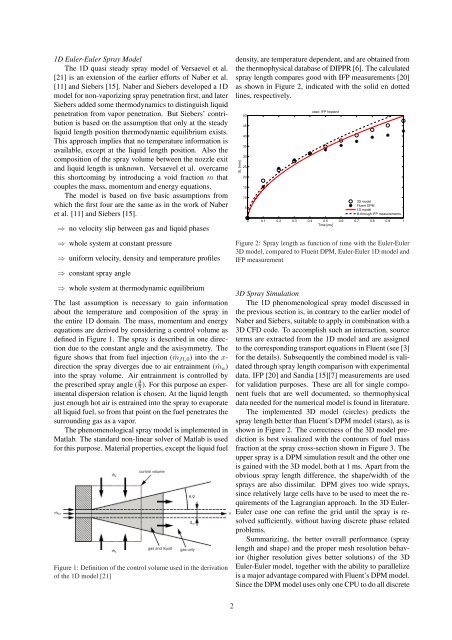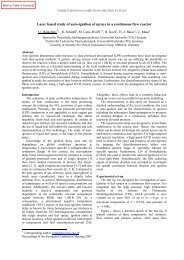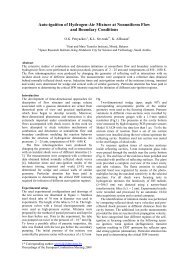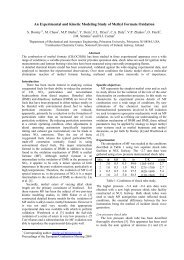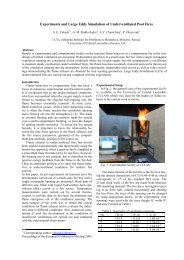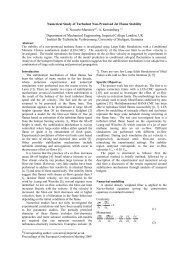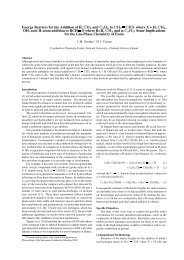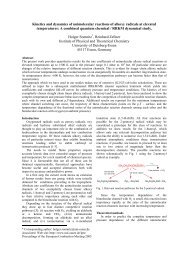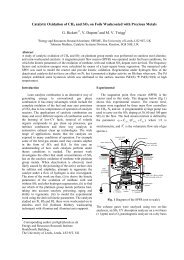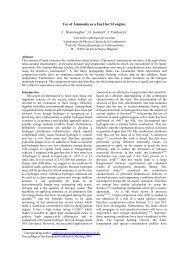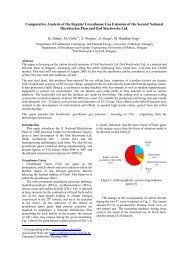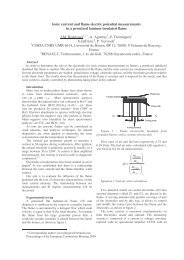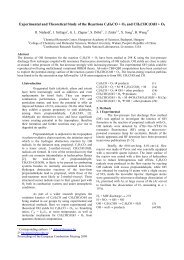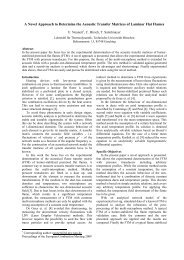Numerical Modeling of Diesel Spray Formation and Combustion C ...
Numerical Modeling of Diesel Spray Formation and Combustion C ...
Numerical Modeling of Diesel Spray Formation and Combustion C ...
Create successful ePaper yourself
Turn your PDF publications into a flip-book with our unique Google optimized e-Paper software.
1D Euler-Euler <strong>Spray</strong> Model<br />
The 1D quasi steady spray model <strong>of</strong> Versaevel et al.<br />
[21] is an extension <strong>of</strong> the earlier efforts <strong>of</strong> Naber et al.<br />
[11] <strong>and</strong> Siebers [15]. Naber <strong>and</strong> Siebers developed a 1D<br />
model for non-vaporizing spray penetration first, <strong>and</strong> later<br />
Siebers added some thermodynamics to distinguish liquid<br />
penetration from vapor penetration. But Siebers’ contribution<br />
is based on the assumption that only at the steady<br />
liquid length position thermodynamic equilibrium exists.<br />
This approach implies that no temperature information is<br />
available, except at the liquid length position. Also the<br />
composition <strong>of</strong> the spray volume between the nozzle exit<br />
<strong>and</strong> liquid length is unknown. Versaevel et al. overcame<br />
this shortcoming by introducing a void fraction m that<br />
couples the mass, momentum <strong>and</strong> energy equations.<br />
The model is based on five basic assumptions from<br />
which the first four are the same as in the work <strong>of</strong> Naber<br />
et al. [11] <strong>and</strong> Siebers [15].<br />
⇒ no velocity slip between gas <strong>and</strong> liquid phases<br />
⇒ whole system at constant pressure<br />
⇒ uniform velocity, density <strong>and</strong> temperature pr<strong>of</strong>iles<br />
⇒ constant spray angle<br />
⇒ whole system at thermodynamic equilibrium<br />
The last assumption is necessary to gain information<br />
about the temperature <strong>and</strong> composition <strong>of</strong> the spray in<br />
the entire 1D domain. The mass, momentum <strong>and</strong> energy<br />
equations are derived by considering a control volume as<br />
defined in Figure 1. The spray is described in one direction<br />
due to the constant angle <strong>and</strong> the axisymmetry. The<br />
figure shows that from fuel injection ( ˙mfl,0) into the xdirection<br />
the spray diverges due to air entrainment ( ˙ma)<br />
into the spray volume. Air entrainment is controlled by<br />
the prescribed spray angle ( θ<br />
2 ). For this purpose an experimental<br />
dispersion relation is chosen. At the liquid length<br />
just enough hot air is entrained into the spray to evaporate<br />
all liquid fuel, so from that point on the fuel penetrates the<br />
surrounding gas as a vapor.<br />
The phenomenological spray model is implemented in<br />
Matlab. The st<strong>and</strong>ard non-linear solver <strong>of</strong> Matlab is used<br />
for this purpose. Material properties, except the liquid fuel<br />
.<br />
mfl,0<br />
.<br />
ma<br />
.<br />
ma<br />
control volume<br />
/2<br />
d eff<br />
gas <strong>and</strong> liquid gas only<br />
Figure 1: Definition <strong>of</strong> the control volume used in the derivation<br />
<strong>of</strong> the 1D model [21]<br />
df<br />
x<br />
2<br />
density, are temperature dependent, <strong>and</strong> are obtained from<br />
the thermophysical database <strong>of</strong> DIPPR [6]. The calculated<br />
spray length compares good with IFP measurements [20]<br />
as shown in Figure 2, indicated with the solid en dotted<br />
lines, respectively.<br />
SL [mm]<br />
50<br />
45<br />
40<br />
35<br />
30<br />
25<br />
20<br />
15<br />
case: IFP heptane<br />
10<br />
5<br />
3D model<br />
Fluent DPM<br />
1D model<br />
fit through IFP measurements<br />
0<br />
0 0.1 0.2 0.3 0.4 0.5<br />
Time [ms]<br />
0.6 0.7 0.8 0.9 1<br />
Figure 2: <strong>Spray</strong> length as function <strong>of</strong> time with the Euler-Euler<br />
3D model, compared to Fluent DPM, Euler-Euler 1D model <strong>and</strong><br />
IFP measurement<br />
3D <strong>Spray</strong> Simulation<br />
The 1D phenomenological spray model discussed in<br />
the previous section is, in contrary to the earlier model <strong>of</strong><br />
Naber <strong>and</strong> Siebers, suitable to apply in combination with a<br />
3D CFD code. To accomplish such an interaction, source<br />
terms are extracted from the 1D model <strong>and</strong> are assigned<br />
to the corresponding transport equations in Fluent (see [3]<br />
for the details). Subsequently the combined model is validated<br />
through spray length comparison with experimental<br />
data. IFP [20] <strong>and</strong> S<strong>and</strong>ia [15][7] measurements are used<br />
for validation purposes. These are all for single component<br />
fuels that are well documented, so thermophysical<br />
data needed for the numerical model is found in literature.<br />
The implemented 3D model (circles) predicts the<br />
spray length better than Fluent’s DPM model (stars), as is<br />
shown in Figure 2. The correctness <strong>of</strong> the 3D model prediction<br />
is best visualized with the contours <strong>of</strong> fuel mass<br />
fraction at the spray cross-section shown in Figure 3. The<br />
upper spray is a DPM simulation result <strong>and</strong> the other one<br />
is gained with the 3D model, both at 1 ms. Apart from the<br />
obvious spray length difference, the shape/width <strong>of</strong> the<br />
sprays are also dissimilar. DPM gives too wide sprays,<br />
since relatively large cells have to be used to meet the requirements<br />
<strong>of</strong> the Lagrangian approach. In the 3D Euler-<br />
Euler case one can refine the grid until the spray is resolved<br />
sufficiently, without having discrete phase related<br />
problems.<br />
Summarizing, the better overall performance (spray<br />
length <strong>and</strong> shape) <strong>and</strong> the proper mesh resolution behavior<br />
(higher resolution gives better solutions) <strong>of</strong> the 3D<br />
Euler-Euler model, together with the ability to parallelize<br />
is a major advantage compared with Fluent’s DPM model.<br />
Since the DPM model uses only one CPU to do all discrete


